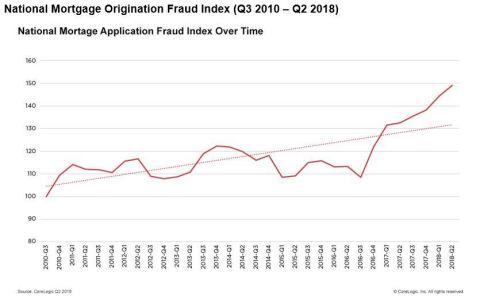- Risk index has continually increased for the last seven quarters
- States with heavy out-of-state investment showed significantly higher fraud risk
- All loan segments showed increased risk year over year
IRVINE, Calif. — (BUSINESS WIRE) — September 13, 2018 — CoreLogic® (NYSE: CLGX), a leading global property information, analytics and data-enabled solutions provider, today released its latest Mortgage Fraud Report. The report shows a 12.4 percent year-over-year increase in fraud risk at the end of the second quarter, as measured by the CoreLogic Mortgage Application Fraud Risk Index.
This press release features multimedia. View the full release here: https://www.businesswire.com/news/home/20180913005169/en/

National Mortgage Origination Fraud Index (Q3 2010 – Q2 2018) (Graphic: Business Wire)
The analysis found that during the second quarter of 2018, an estimated one in 109 applications, or 0.92 percent of all mortgage applications, contained indications of fraud, compared with the reported one in 122, or 0.82 percent in the second quarter of 2017.
The CoreLogic Mortgage Fraud Report analyzes the collective level of loan application fraud risk experienced in the mortgage industry each quarter. CoreLogic develops the index based on residential mortgage loan applications processed by CoreLogic LoanSafe Fraud Manager™, a predictive scoring technology. The report includes detailed data for six fraud type indicators that complement the national index: identity, income, occupancy, property, transaction and undisclosed real estate debt.
“This year’s trend continues to show an increase in mortgage fraud risk year over year,” said Bridget Berg, principal of Fraud Solutions Strategy for CoreLogic. “Because home prices are rising, and demand is strong, most mortgage fraud in this type of market is motivated by bona fide borrowers trying to qualify for a mortgage. Undisclosed real estate liabilities, credit repair, questionable down payment sources and income falsification are the most likely misrepresentations.”
Report Highlights:
- New York, New Jersey and Florida remain the top three states for mortgage application fraud risk, maintaining the same positions as last year.
- All of the top 10 riskiest states showed increases in risk year over year.
- States with the greatest year-over-year risk growth include New Mexico, Mississippi, Illinois, Oklahoma and Texas. Of these, New Mexico, Illinois and Oklahoma now have risk levels greater than the National Index, which grew from 133 to 149 year over year.
- The conforming loans for home purchases segment shows the greatest risk increase by loan type.
- Income fraud risk had the greatest increase year over year, followed by occupancy and transaction fraud. Property and undisclosed real estate debt showed declines in risk.
To view the full CoreLogic Mortgage Fraud Report, visit www.corelogic.com/mortgagefraudreport.
Methodology
Our comprehensive fraud risk analysis is based on a lender-driven mortgage fraud consortium and leading predictive-scoring technology.
The CoreLogic Mortgage Application Fraud Risk Index represents the collective level of fraud risk the mortgage industry is experiencing in each time period, based on the share of loan applications with a high risk of fraud. The index is standardized to a baseline of 100 for the share of high-risk loan applications nationally in the third quarter of 2010. Each one-point change in the index represents a 1 percent change in the share of mortgage applications having a high risk of fraud.
The estimated number of fraudulent applications is derived by applying the current risk level of CoreLogic Mortgage Fraud Consortium applications to industry volumes.
The Fraud Type Indicators are based on specific CoreLogic LoanSafe Fraud Manager alerts. These alerts are compiled consistently for all CoreLogic Mortgage Fraud Consortium members. Indicator levels are based on the prevalence and predictive ability of the relevant alerts. An increase in the indicator correlates with increased risk of the corresponding fraud type.
Source: CoreLogic
The data provided is for use only by the primary recipient or the
primary recipient's publication or broadcast. This data may not be
re-sold, republished or licensed to any other source, including
publications and sources owned by the primary recipient's parent company
without prior written permission from CoreLogic. Any CoreLogic data used
for publication or broadcast, in whole or in part, must be sourced as
coming from CoreLogic, a data and analytics company. For use with
broadcast or web content, the citation must directly accompany first
reference of the data. If the data is illustrated with maps, charts,
graphs or other visual elements, the CoreLogic logo must be included on
screen or website. For questions, analysis or interpretation of the
data, contact Alyson Austin at
newsmedia@corelogic.com
or Allyse Sanchez at
corelogic@ink-co.com .
Data provided may not be modified without the prior written permission
of CoreLogic. Do not use the data in any unlawful manner. This data is
compiled from public records, contributory databases and proprietary
analytics, and its accuracy is dependent upon these sources.

